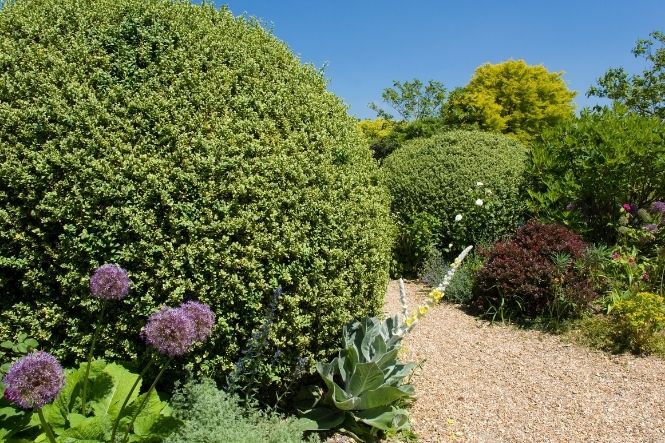The use of gravel in gardens has become very popular in recent years. This is largely down to a trend for low-maintenance gardens, either for buy-to-let properties or for busy homes where families want to relax in the garden rather than maintain it.
Where to Use Gravel
You can lay gravel either over part of a garden or the whole garden, have plants in containers standing on it, or have plants growing through it. If only part of the garden is to be graveled, then you will need to bound the area with some hard barrier, a piece of treated timber, decorative Edging Blocks or Bricks. This is to stop the gravel escaping as it will play havoc with a lawnmower if there’s grass next to it, for example.
Gravel isn’t really suitable for sloping gardens unless the area can be terraced, otherwise the gravel will eventually all end up at the bottom of the slope. The terracing doesn’t have to be a massive project, just 5cm-high (2in) battens of treated timber fixed at appropriate intervals to arrest the effects of gravity, or perhaps some decorative clay or concrete blocks, whatever will match with the rest of the garden’s hard landscaping.
If you have children, gravel is relatively kind to them, depending on the size and how rounded it is. But it has to be laid to a significant depth to allow some give to absorb impacts, probably something like 15 or even 20cm. An informal garden, on the other hand, with no pretensions toward child safety, can do with as little as 5cm, particularly if it’s not going to be walked on a great deal.
Choosing Gravel
There is a huge choice of gravel available, offering different shapes, sizes, grade and colours. For a garden, the right size is likely to be between 6 to 18mm, as anything larger is hard to walk over and anything smaller wouldn’t stay in place. It makes sense to get rounded gravel for a garden as some of the cheaper gravels used commercially in car parks and the like can be very sharp, particularly flint gravel.
The best solution is to get down to a builders’ yard or garden centre and make your choice. Or if a friend or neighbour has had some gravel laid down that you like, ask them what it was and where they got it from.
Laying Gravel Down
Excavation for gravel is really only a case of skimming off the top layer of grass or topsoil. It’s wise to lay a weed-proof membrane or a permeable landscape fabric down to stop deep rooted plants like dandelions pushing their way through the gravel. But don’t put weed inhibitor down if you are going to plant through the gravel.
Once the area is prepared, simply pour on the gravel and spread it to an even thickness with a shovel and then a rake. Gravel can be compacted if required. This might give a more solid surface and keep the gravel in place, but it’s not absolutely necessary.
Planting through the Gravel
To plant through the gravel, once it is all laid, scrape it away from the right spot and cut a cross-shaped slit in the membrane. Peel the corners of the cross back and dig a hole of the correct size. Then bed the plant down, fold the flaps of the membrane back, cutting off any excess, and push the gravel back around the plant.
Even with a membrane in place, gravel isn’t completely weed proof. There are many plants that will happily take root in an inch of gravel. Luckily, they will not have strong root systems so they can be easily lifted out by hand.
For more information on using gravel, read our articles Looking After Gravel Drives and We Rejuvenated Gravel For Use In The Garden on this site.

